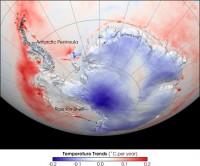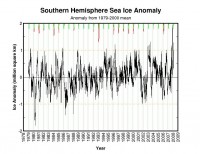By Joseph D’Aleo, CCM
Last year when Antarctic set a new record for ice extent, it got no media attention. They focused on the north polar regions where the ice set record low levels. This summer when unprecedented anomalous cover continued in the Southern Hemisphere again no coverage. Then this report in the news today. You probably saw it on your favorite network or internet news site (pick one, anyone).
Vast Antarctic Ice Shelf on Verge of Collapse - Latest Sign of Global Warming’s Impact Shocks Scientists
Andrea Thompson Livescience
A vast ice shelf hanging on by a thin strip looks to be the next chunk to break off from the Antarctic Peninsula, the latest sign of global warming’s impact on Earth’s southernmost continent. Scientists are shocked by the rapid change of events. Glaciologist Ted Scambos of the University of Colorado was monitoring satellite images of the Wilkins Ice Shelf and spotted a huge iceberg measuring 25 miles by 1.5 miles (37 square miles) that appeared to have broken away from the shelf. Scambos alerted colleagues at the British Antarctic Survey (BAS) that it looked like the entire ice shelf - about 6,180 square miles (about the size of Northern Ireland)- was at risk of collapsing. The region where the Wilkins Ice Shelf lies has experienced unprecedented warming in the past 50 years, with several ice shelves retreating in the past 30 years. Six of these ice shelves have collapsed completely: Prince Gustav Channel, Larsen Inlet, Larsen A, Larsen B, Wordie, Muller and the Jones Ice Shelf. See MSNBC version of this story here.
Icecap Note: Let’s put this in perspective. The account may be misinterpreted by some as the ice cap or a significant (vast) portion is collapsing. In reality it and all the former shelves that collapsed are small and most near the Antarctic peninsula which sticks well out from Antarctica into the currents and winds of the South Atlantic and lies in a tectonically active region with surface and subsurface active volcanic activity. The vast continent has actually cooled since 1979.

See full image here
The full Wilkins 6,000 square mile ice shelf is just 0.39% of the current Antarctic ice cover (just 0.1% of the extent last September). A very small piece broke off as an iceberg (37 square miles). Then only a small portion of it around 160 square miles partially disintegrated late this February into early March. That represents just 2.67% of the full Wilkins ice sheet and 0.01% of the total Antarctic icecover (0.003% of its level last September), a little like an icicle falling from a snow and ice cover roof. No big deal (unless you are standing beneath it).
And this winter is coming on quickly. Satellite images show the ice has already refrozen around the broken pieces and expanded. In fact the ice is returning so fast, it is running an amazing 60% ahead (4.0 vs 2.5 million square km extent) of last year when it set a new record. The ice extent is already approaching the second highest level for extent since the measurements began by satellite in 1979 and just a few days into the Southern Hemisphere fall season and 6 months ahead of the peak. We are very likely going to exceed last year’s record. Yet the world is left with the false impression Antarctica’s ice sheet is also starting to disappear. See pdf of this story for posting here.

See full image here Source: The Cryosphere Today
One Icecap reader points also to a paper (Glasser et al, 2008) identifying some of the other natural processes that can lead to these ice sheet breaks, in this case Larsen B.


